This post may contain affiliate links. For more information, see our privacy policy.
Much easier than traditional Coq au Vin but just as delicious, the magical tenderizing trick results in amazingly tender chicken. It's a fabulous, make-ahead dish that's perfect for entertaining or an easy weeknight treat.
This Coq au Vin recipe was inspired by a market cooking class that Scott and I had the pleasure of taking in Paris this past summer, hence the name, Parisian Coq au Vin. We met with Paulo, our instructor at a magnificent local market, shopped for our dinner supplies then traveled to Le Foodist, a beautiful cooking school in the city's heart. The chef gave us assignments and we got to work, making a traditional French meal. The Coq au Vin was one of the delicious highlights of the fun evening.
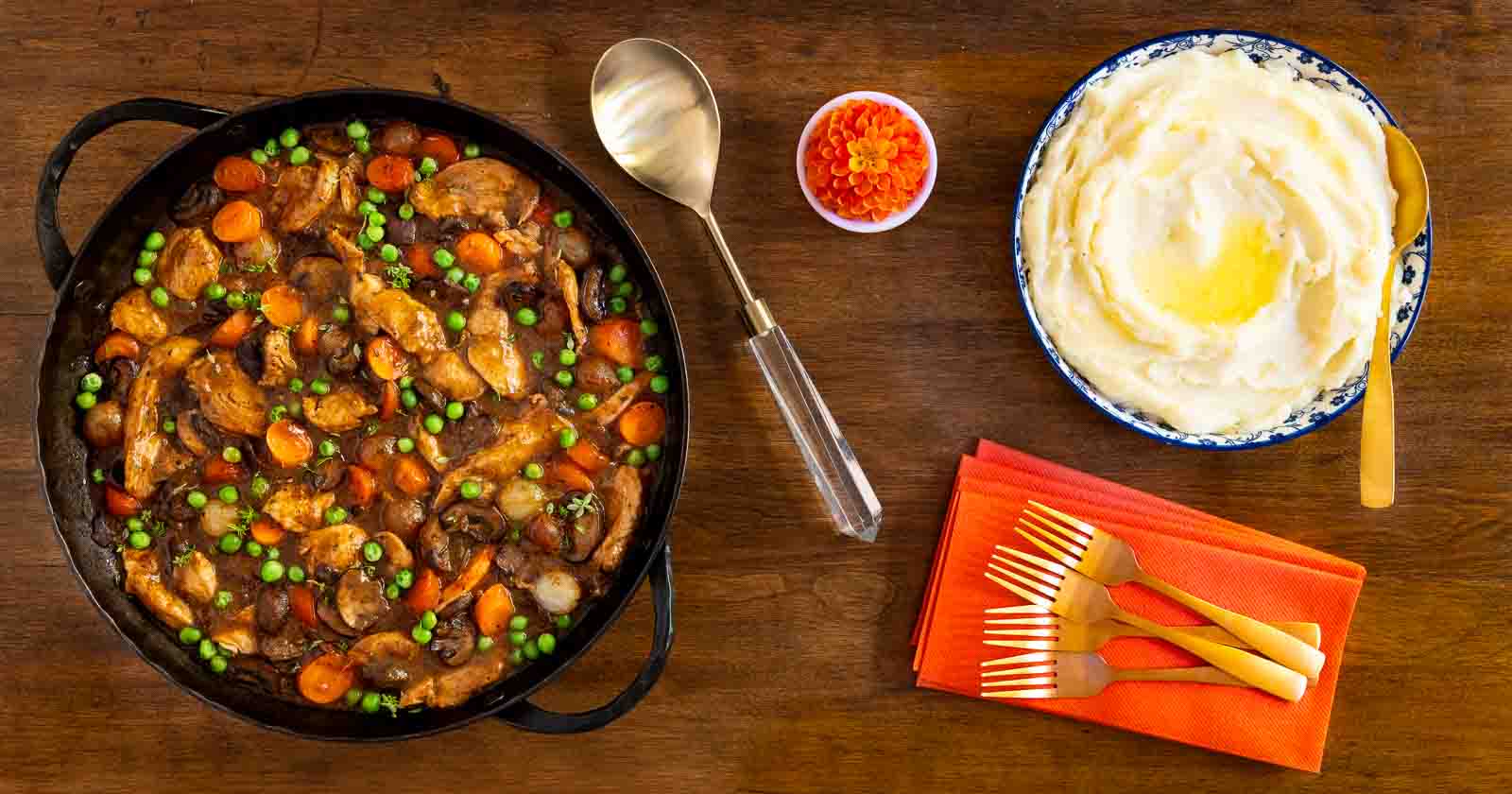
What's Coq au Vin?
In the Paris class, Paulo explained that Coq au Vin translates to "rooster in wine". He went on to say that, like other classic French dishes (i.e. Beef Bourguignon) that are now thought of as fine cuisine, Coq au Vin was born of peasant frugality. In the early days, it was made with tougher, inexpensive cuts of meat (like old roosters) which became tender after a long slow braise in wine.
Although the exact origin of this dish is not known, it's thought to go back over 400 years. Julia Child brought Coq au Vin to notoriety after featuring it in her famous books, Mastering the Art of French Cooking and "The French Chef". These days, classic Coq au Vin consists of chicken that's slow braised in wine along with bacon, mushrooms and pearl onions, although throughout France, there are lots of variations depending on the region and the chef.
A myriad of variations
Paulo's version was his unique rendition, made with boneless chicken breasts instead of the traditional skin-on, bone-in chicken pieces. I loved the way Paulo created layers of flavor in a delicious sauce that didn't require hours in the kitchen.
In the class, we flattened the chicken breasts, then rolled them into sausage shapes and wrapped them in cooking-grade plastic. The little chicken "sausages" were simmered in the sauce, creating a simple sous vide. I took tips from Chef Paulo's expertise and set out to create a streamlined Coq au Vin that would be full of flavor yet doable in right around an hour.
After a few attempts, I'm quite happy with the results. I love that my recipe comes together quickly and can be made ahead. Like our Parisian Coq au Vin, the sauce has layers of flavor created with mushrooms, bacon, shallots, herbs and spices. Because I'm a big fan of sneaking in extra veggies in my recipes, I've also included carrots and tiny tender peas in my Coq au Vin.
The chicken is super tender thanks to a favorite trick of mine, an age-old Asian technique called "velveting".
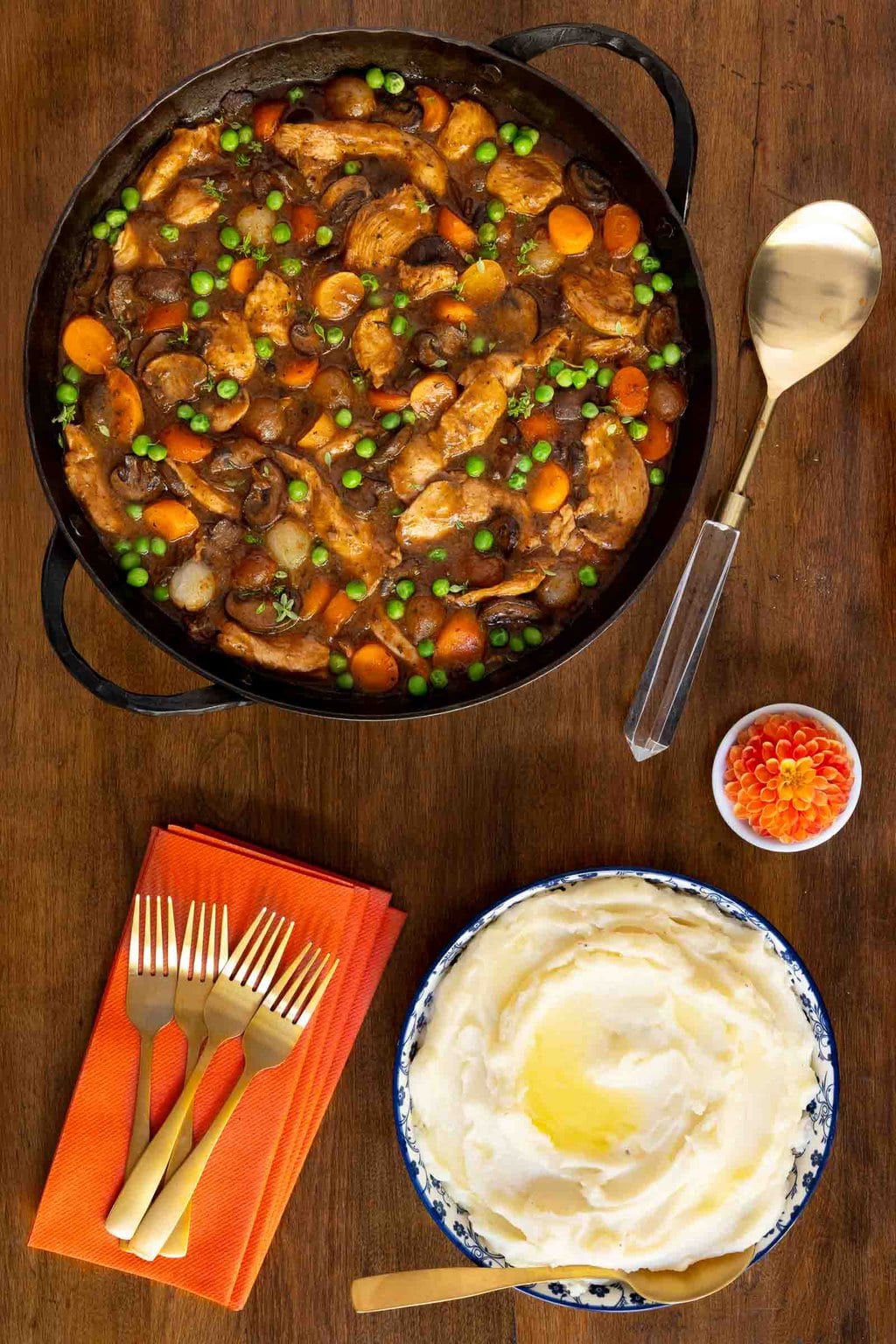
What is velveting?
Have you ever noticed how tender the chicken is when dining at an Asian restaurant? The tenderness is due to a simple technique called velveting. The culinary gurus at Bon Appetit describe velveting as, "The culinary technique that takes stir-fries to the next level."
So what is velveting? Although there are variations, velveting is a method of marinating that keeps delicate meat and seafood moist and tender during cooking. The marinade ingredients can vary a bit, but generally include egg white, cornstarch, vinegar and a splash of oil. Kikoman (the soy sauce folks) explain that the marinade creates a "coating that acts as a protective barrier which seals in the moisture and also helps prevent the food from overcooking and becoming tough."
I came across this magical marinating technique years ago and began using it with stir-fries. It worked so well that I now employ it frequently and beyond the realm of Asian cuisine, as in this Parisian Coq au Vin. I like to cross international lines when it comes to cuisine!
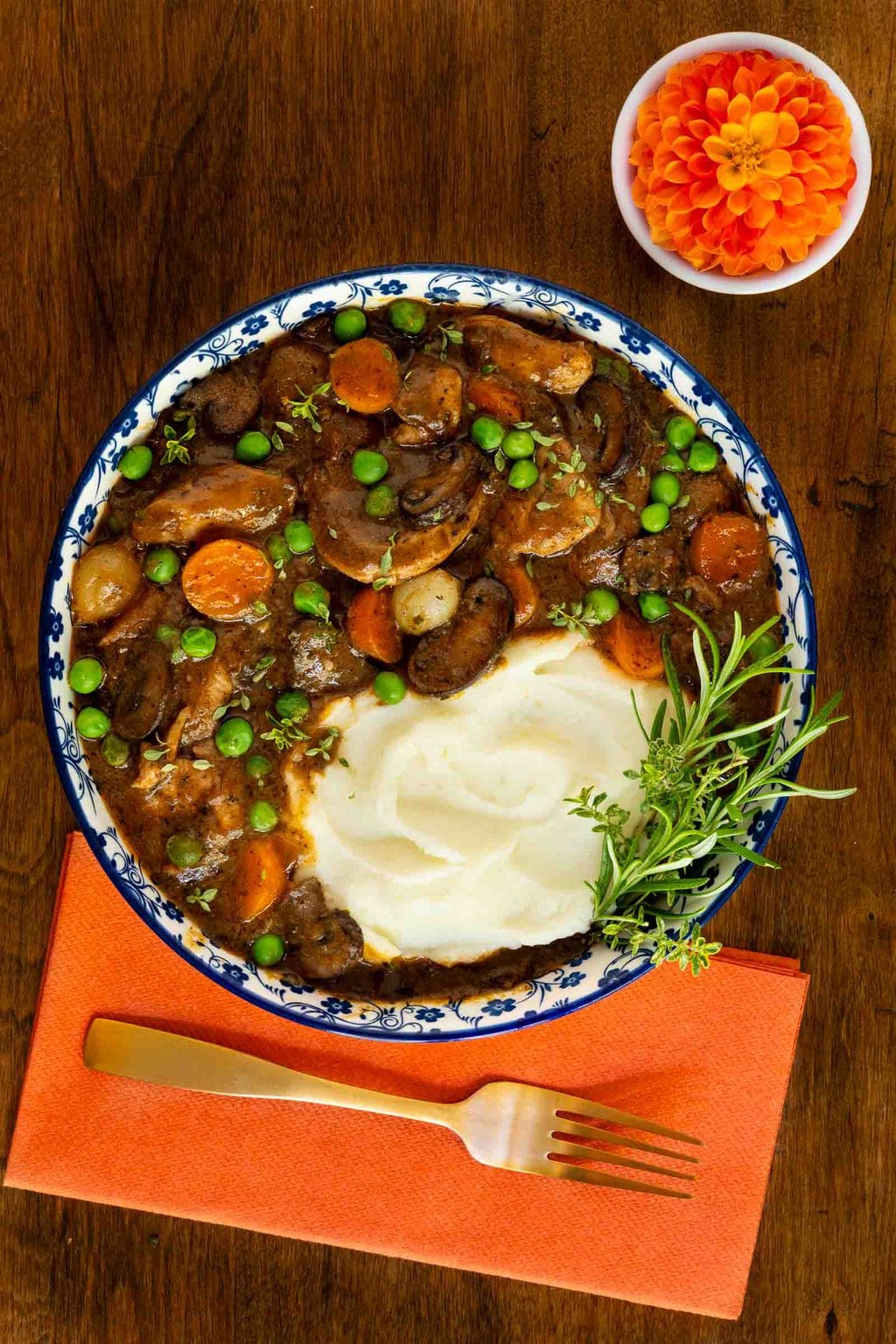
What to serve with this Parisian Coq au Vin
Coq au Vin is often paired with mashed potatoes, but it's also deliciuos with pasta and egg noodles too. Julia Child suggests in her recipe, "to accompany it with parsley potatoes, rice, or noodles; buttered green peas or green salad; hot French bread; and the same red wine you used for cooking the chicken."
Serve this Parisian Coq au Vin on its own or with whatever you prefer. It makes a delicious dinner and the fact that it can be made ahead is perfect for stressless entertaining and easy weeknight meals. It's also a wonderful way to take a culinary trip to France without ever leaving home.
Bon Appétit!
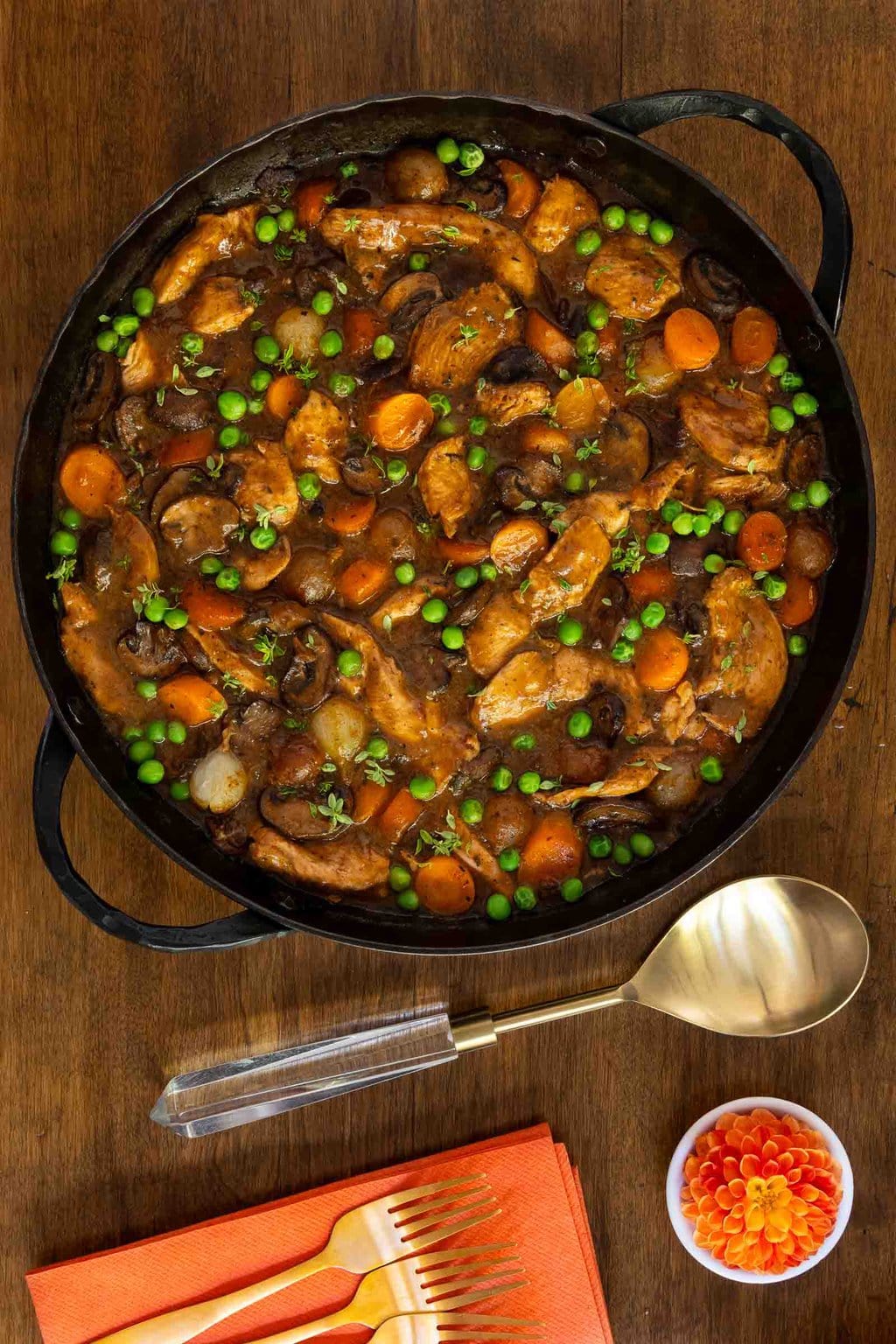
Cafe Tips for making this Parisian Coq au Vin
- Although I don't buy organic across the board, I do prefer organic chicken. I find it more tender and the individual portions aren't ridiculously large.
- What type of wine to use for this Coq au Vin? I like to use a Pinot Noir or a Burgundy but any dry red wine will work. The rule of thumb when cooking with wine is that it doesn't have to be super expensive but rather a wine that you would enjoy drinking.
- Feel free to use regular carrots for this recipe or baby carrots. If using baby carrots, I like to look for fatter carrots vs the little thin ones.
- You may have heard that you shouldn't wash mushrooms but should simply "brush" them off. I disagree with that advice. Mushrooms are grown in dirt and sometimes in manure. The dirt (or manure) may be sterilized but it still needs to be washed off before cooking. I run my mushrooms under cold running water and rub off any dirt with my hands.
- This recipe calls for pearl onions. You can purchase pearl onions in the produce section of many larger grocery stores near the other onions, however, they are labor-intensive and time-consuming to peel. I like to purchase frozen pearl onions, already peeled and ready to go!
- How to prep this Coc au Vin ahead? Make it through step 7 under For the sauce: At this point, you can either refrigerate the sauce and sliced chicken or hold the sauce at room temperature for an hour. If refrigerated, bring it out about 30 minutes before serving and warm it slowly. Marinate the chicken for 20 minutes as directed then drain. Once the sauce and veggies come to a nice simmer, add the chicken, stir, cover and turn off the heat. Dinner is ready to serve in 10 minutes!
This recipe calls for Herbes de Provence which is a classic blend of herbs often used in French cuisine. It's available in the spice section of most larger grocery stores and online. It adds a nice layer of flavor to this Coq au Vin. - Be sure to take the time to reduce the wine to a thick, concentrated syrupy consistency. This will take about 8-10 minutes but it will eliminate any harsh flavor and bring out the fabulous flavor of the tannins. Reducing the wine also gives the finished sauce a lovely consistency.
- A beurre manié is used in this recipe to thicken the sauce right before the chicken is added. A beurre manié is simply a fancy French word that means "kneaded butter". All you need for a beurre manié is soft butter and flour. The two ingredients are combined in equal amounts and added to the simmering sauce. Cook's Illustrated explains a beurre manié: "If flour were added directly to hot liquid, it would clump; in a beurre manié, the flour particles are coated in fat, so as the butter melts, it seamlessly disperses the flour particles, which swell and thicken the liquid.
- I like to use a braiser pan with a tight-fitting lid. You can also use a lidded cast iron pan or a heavy-duty stainless steel pan. I don't recommend non-stick for this recipe as you want the fond to stick to the bottom of the pan as you cook the mushrooms and bacon. This helps develop delicious flavor.
- This last tip is completely optional but may be a life-saver on a busy day. Most larger grocery stores have packages of pre-made mashed potatoes. I was very leery of packaged potatoes, thinking that they were artificial potatoes or made from potato flakes. I decided to try them a while back and was quite surprised at how they tasted just like homemade mashed potatoes. These potatoes can be warmed on the stovetop, in the microwave or the oven. I like the brand called Simply Potatoes which is made from real potatoes, real butter and real dairy. You'll usually find them in the dairy section of the grocery store in the same area as the fresh pasta. Since they are not frozen, be sure to check the date for freshness. Using them may save that one last frenzied step when entertaining and no one will know when they are paired with this delicious Parisian Coq au Vin!
Thought for the day:
Not to us, O LORD,
not to us but to your name
be the glory,
because of your love and faithfulness.
Psalm 115:1
What we're listening to for inspiration:
If you enjoy this recipe, please come back and leave a star rating and review! It’s so helpful to other readers to hear your results, adaptations and ideas for variations.

Easy, Make-Ahead Parisian Coq au Vin (with boneless chicken breasts)
Ingredients
For the prep:
- 8 ounces button mushrooms, (I like cremini but regular button mushrooms will also work)
- 8 ounces carrots, about 4 medium carrots
- 1 large shallot
- 4 medium garlic cloves
- 3 slices smoky, thick-cut bacon
- 1 ½ pounds boneless, skinless chicken breasts
For the mushrooms:
- ½ cup low sodium chicken broth
- ½ teaspoon kosher salt
- ¼ teaspoon black pepper
- 1 tablespoon butter
For the sauce:
- 2 tablespoon tomato paste
- 1 ½ cups dry red wine, (I like a Burgundy or Pinot Noir but almost any dry, red wine will work!)
- 3 cups low sodium chicken broth, maybe a bit more
- 1 teaspoon brown sugar
- 2 teaspoons low sodium soy sauce
- 2 medium bay leaves
- 1 teaspoon Herbes de Provence
- 4-5 medium-size fresh thyme sprigs
- 2 teaspoons finely chopped fresh rosemary, divided
- ½ teaspoon kosher salt, more to taste
- 2 tablespoons all-purpose flour
- 1 ½ cups frozen pearl onions, thawed
- 2 tablespoons soft butter
For the chicken marinade:
- 1 large egg white, from one large egg
- 2 teaspoons corn starch
- 2 teaspoons apple cider vinegar, any kind of vinegar will work
- 1 teaspoon extra virgin olive oil
To finish:
- 1 cup tiny frozen peas, thawed
- fresh thyme leaves and rosemary sprigs, for garnish, if desired
Instructions
For the prep:
- Wash the mushrooms under warm running water, rubbing all sides to remove the dirt. Lay the mushrooms on a clean kitchen towel after washing then cut into ¼-inch slices. Set aside.
- Peel the carrots if using whole carrots. Slice them into ½-inch slices on a slight diagonal. Set aside.
- Finely chop the shallot and mince the garlic cloves with a garlic press or a sharp knife. Set aside separately.
- Stack the bacon strips on top of each other and cut the stack in half width-wise. Cut each stack in half length-wise then cut into ¼-inch slices.
- Trim any excess fat from the chicken breasts then cut, width-wise on a slight diagonal into ¼ inch slices. Refrigerate sliced chicken for now.
For the mushrooms
- Combine the mushrooms, ½ cup of chicken broth, ½ teaspoon kosher salt and ¼ teaspoon black pepper in a large lidded cast iron or sauté pan or heavy-duty braiser or skillet (not a non-stick pan).
- Cook over medium-high heat for about 6-8 minutes or until most of the liquid has evaporated, stirring occasionally.
- Push the mushrooms to the side of the pan and add the butter in the center. When the butter is melted, stir to coat the mushrooms then spread to a single layer.
- Reduce the heat to medium and allow the mushrooms to cook undisturbed for 1-2 minutes, until turning golden on the underside. Stir well then spread to a single layer again and cook another 1-2 minutes. Repeat if needed until the mushrooms are nicely browned. Remove them from the pan to a clean plate or bowl. Do not wash the pan.
For the sauce:
- Keeping the heat on medium, add the diced bacon to the pan and cook for 5-7 minutes until crisp and golden brown, stirring frequently. Remove the bacon with a slotted spoon to a clean plate or bowl. Set aside.
- Reduce the heat to low and add the chopped shallots. Stir and cook for 2 minutes until softened. Add the minced garlic and tomato paste and stir again. Cook for 1-2 more minutes, stirring continuously, until the tomato paste darkens a bit and the mixture is fragrant.
- Add the red wine, increase the heat to medium-high and bring the mixture to a boil, stirring occasionally. Reduce to a syrupy, thick glaze. Watch it carefully near the end so it doesn’t burn.
- Add the chicken broth, brown sugar, soy sauce, bay leaves, Herbes de Provence, thyme sprigs, half of the chopped rosemary, the carrots, pearl onions, reserved bacon and the mushrooms (reserve a few for garnish, if desired).
- Bring to a boil then reduce to a steady simmer and cover. Cover and cook for 20 minutes, until the carrots are nice and tender.
- Combine the soft butter and the flour and stir until lump-free.
- Add the butter mixture (beurre manié) to the simmering sauce, one tablespoon at a time, stirring well after each addition, until desired thickness is achieved. (You may have a bit of beurre manié left over.) (At this point, you could cool and refrigerate the sauce until ready to finish or finish now and serve.)
To finish:
- Prepare the chicken marinade while the sauce is simmering by combining the egg white, cornstarch, vinegar and oil in a medium-size bowl. Add the sliced chicken and massage for 20-30 seconds with your hand. Set aside to marinate for 20 minutes.
- After the chicken has marinated in the egg white mixture for 20 minutes, add it to the simmering sauce and stir to separate the pieces.
- Return to a nice steady simmer, add the peas and remaining rosemary, then stir once more. Cover the pan tightly and turn off the heat. Allow the pan to sit undisturbed for 10 minutes.
- Uncover and, if you prefer a thinner sauce, add a bit more broth. Stir well then taste. Add more salt, if needed. Garnish with fresh thyme, and the reserved mushrooms, if desired.
- Serve and ENJOY!
Notes
Nutrition
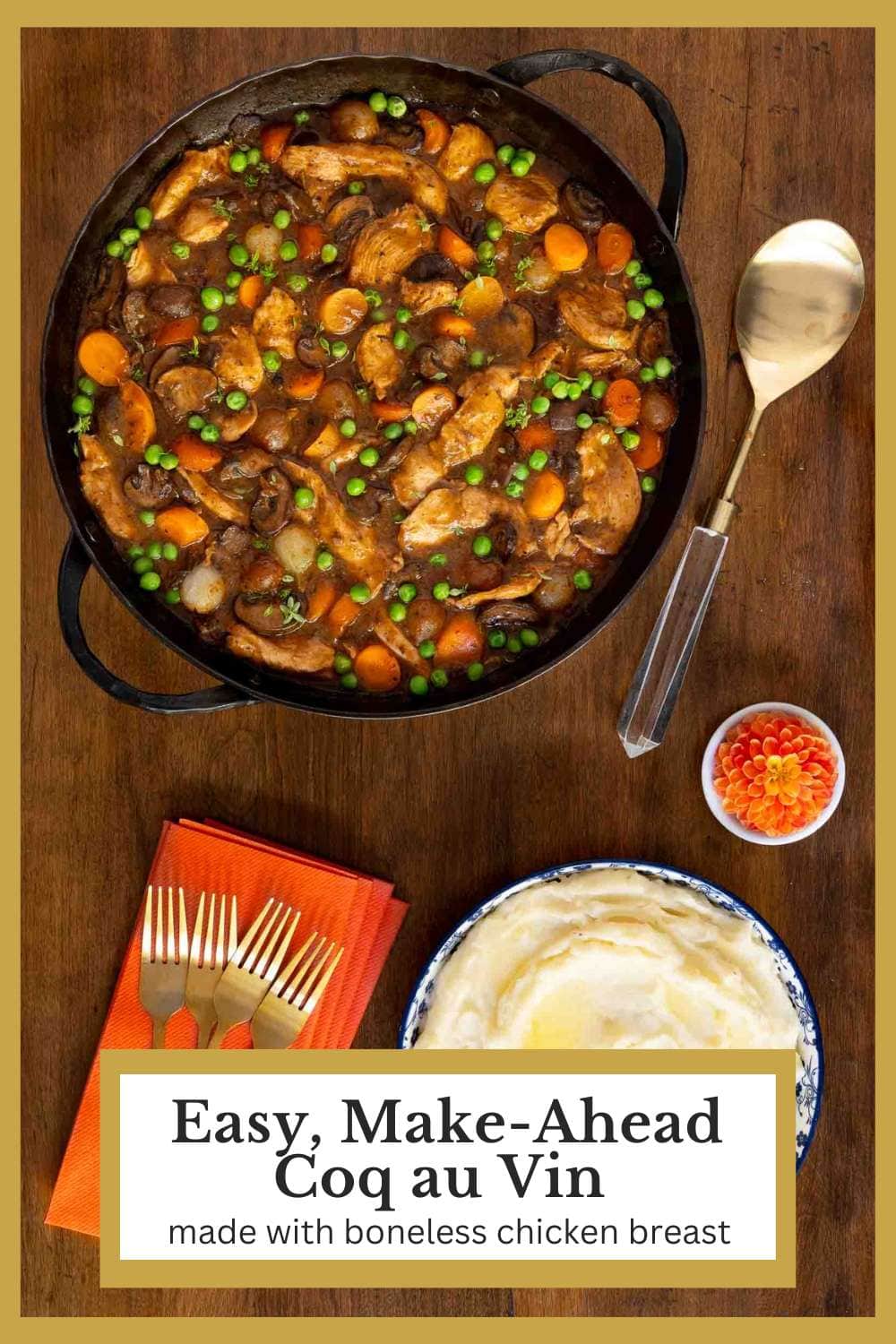


Michael says
Thanks for the great recipe. My wife won't eat dark meat chicken which has limited my ability to make coq au vin using "traditional" recipes. This recipe worked great, and produced a nice result. I was amazed that the chicken breast wasn't dry or tough! Thanks, again.
Lindsay @ The Café Sucre Farine says
Awesome! Thanks for the review, Michael!
Inge A Kohl says
Made this tonight and it was amazing. I served it with some spaetzle I had previously made and frozen.
There are a couple of things that made me reread the instructions several times. While it's helpful to have the prep instructions, it was also a little confusing. I saw 4 garlic cloves in the prep section and then 4 more for the sauce. Turns out those are the same 4 cloves of garlic.
I also didn't see you mention the soy sauce in step 4 for the sauce. I assumed that's where it was added.
I added the peas before adding the chicken and simmered them for a few minutes. You didn't mention when to add them.
The velveting technique is something I saw on one of your other recipes and I absolutely love it. No more dry chicken breast.
It did take a lot of preparation and I don't think I would call it an easy weeknight treat. It was worth the effort though and I will make it again.
Chris Scheuer says
So happy you enjoyed this recipe, Inge! Thanks for noticing the issues and letting me know! I have amended everything!
Dawna L says
This was simply delicious. I made the sauce the day before, then reheated and added the chicken before serving. The flavour seemed to mellow out a bit overnight in the fridge. I would say this serves 6 generously.
Lindsay @ The Café Sucre Farine says
Awesome! Thank you for your review, Dawna!
Melody Fielding says
Thank you much Chris for sharing the technique of 'velveting'!!! I used this marinade for chicken breast added directly to broth in Wor Won Ton Soup, and again 2 days later, sauteing for chicken Caesar wraps. I have never been fond of breast meat, opting for dark meat as I found the breast either dry or tough. I am thrilled with this tip. It is a real game changer, to say the least. Thanks again!
Lindsay @ The Café Sucre Farine says
That's great, Melody! Thanks for letting us know!
Kathleen says
What about the rolling chicken like sausages? Didn't see any instructions on how to cut chicken up?
Thank you!
Lindsay @ The Café Sucre Farine says
Hi Kathleen, for this version we just sliced the chicken, it's step 5 in the recipe.
Rosie says
Hello, how many servings in your coq au vin?
Thank you,
Rosie
Lindsay @ The Café Sucre Farine says
Hi Rosie, the recipe serves 6. You can find that info on the recipe card to the right of the ingredients. Enjoy!
Amy says
Oh, yum! Can’t wait to try this. I love make-ahead recipes for Sunday meals — do you think it would work to marinate the chicken the day before and stick it in the fridge, so that I could just bring the sauce to a simmer and add in the chicken?
Chris Scheuer says
Hi Amy, I think you could cut the chicken and make the marinade and refrigerate them separately. Then just combine them for 15-20 minutes before adding them to the simmering sauce. I would be concerned that the texture of the chicken would change after marinating that long.
Jeanne Freeman says
This looks delicious! By any chance, would this recipe work for “way-ahead” prep — as in preparing and freezing? Or would the quality of the sauce be compromised too much? Thanks!
Chris Scheuer says
I haven't tried freezing this dish so I can't say for sure. My guess would be that it would be much better made fresh.
Lynn says
Thanks so much for this recipe! I've been searching specifically for boneless Coq au Vin on the internet but without success. I really love (need) recipes that can be made ahead or in a short time and this looks really yummy. Can't wait to try it.
Lindsay @ The Café Sucre Farine says
Enjoy, Lynn!
Laurel says
Hi, under the "For the Sauce" instructions, it looks like Step 5 is a repeat of steps mentioned in Step 4. Can you please clarify?
Thanks
Jan says
What can you use instead of the wine. We have allergies and cannot use wine.
Chris Scheuer says
Hi Jan, there are a lot of recipes that include wine where you can just sub extra broth. With this one, however, the wine is an intricate part of the flavor. I would suggest going with another chicken recipe.
Annette Turner says
Did I miss adding beurre manié to thicken the sauce or the amount? You list brown sugar twice? Adding the mushrooms if you prefer? Can I just make it all ahead and reheat gently? Or do you not recommend that?
Thanks for a great looking recipe as I plan to make it but need clarification.
Chris Scheuer says
Thanks for being my "extra eyes", Annette. I have clarified those things in the recipe!
Regarding the mushrooms, I would recommend using them even if some guests don't like them. They add a nice layer of umami flavor and they can be eaten around or picked out.
Nancy R Keziah says
Thanks for sharing this easier way to do Coq au Vin. I look forward to trying it in the future.
Blessings!
Lindsay @ The Café Sucre Farine says
Hope you enjoy it, Nancy!
Kathleen says
Perhaps a crazy question, but I have yet to find frozen pearl onions in Toronto, Canada. Never had this issue in USA. Can always get the fresh pearl onions to peel, but I have severe arthritis and my hands are badly distorted which makes it very difficult to peel the fresh pearl onions. What would be the best substitute. Shallots cut crosswise or simply chunks of onion. The visual appeal will not be the same, but the taste should still be ok??? Your thoughts? Thanks you for all of your recipe creation and testing. I so look forward to your posts each day.
Chris Scheuer says
Thanks for letting me know about this, Kathleen. I would use diced onion and sauté them briefly in the bacon fat, remove them while the wine reduces and then add them back in with the other sauce ingredients. You will get same flavor!
Simon's Kitchen UK says
I found an easier way to peel the fresh pearl onions and it also works for shallots. All you need to do is put them in a bowl and pour boiling water over them, leave them for a few minutes, and then peel them. They are so much easier to peel. Hope that helps you and others.
Chris Scheuer says
Thanks, I will try that!
Barbara C says
Looks delicious! I've been looking at some of the original Julia Child "The French Chef" videos on YouTube and notice she will simmer her bacon for 10 minutes in order to remove some of the smokey flavor. I plan to do this because I have found that smokiness in bacon to be a bit overwhelming.
Chris Scheuer says
Hi Barbara, it's fine to do that although, with just 3 strips of bacon, there's not an abundance of smokiness. Just a nice layer of additional flavor that melds and marries really nicely.